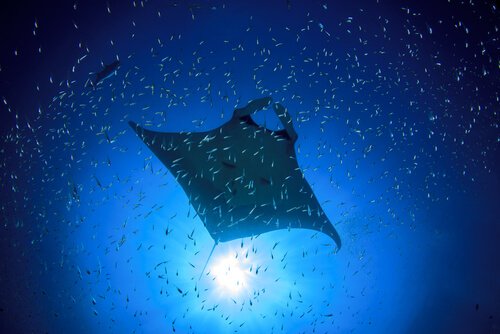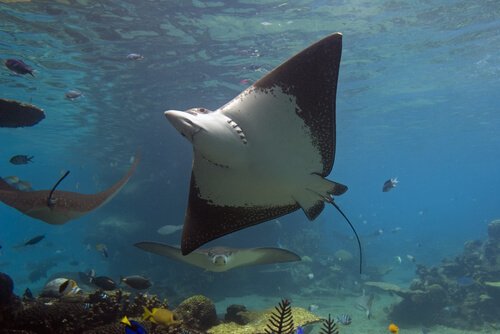Species of Stingray and Their Characteristics


Written and verified by the lawyer Francisco María García
Stingrays are part of a large order of cartilaginous fish that characterized by their thin, flat bodies. They have two pectoral fins and a long tail, and, despite their morphological differences, they’re actually related to sharks. In this article, we’ll give you some information about the different species of stingray, along with their habitat, diet, and reproduction.
Species of stingray and their morphological characteristics
Some of their most outstanding features are their triangular-shaped pectoral fins and their flat dorsoventral area. They also have a cartilaginous endoskeleton and a fused front vertebrae.
Their large and flexible fins play an important role in the way they move. This allows the marine species to propel itself through the water. However, its caudal fin is short or even non-existent, and it doesn’t have an anal fin.
The structure of its tail is similar to that of a whip: long, sharp and thin. It’s usually covered with small, sharp barbs that may contain certain toxins. Some species of stingray have a poisonous tail that can reach up to 30 centimeters in length.
Another typical characteristic is their thin and pointy nose that’s usually covered by a single nasal fin. Also, their corneas are almost always attached to the skin around their eyes, and they don’t have a nictitating membrane.

A stingray’s habitat
The vast majority of stingrays live in saltwater, spread throughout our planet’s oceans. Their ability to adapt to their environment is remarkable. For example, they can live in coastal areas, in the open sea, and even in depths of up to 10,000 feet.
However, there are also species of stingray that have adapted to freshwater and that love to live in estuaries and rivers. An example of this type is the ‘chuchos de río,’ which is native to South America, mostly in the Amazon basin. Many people are afraid of this species because of their powerful and toxic barbs.
Many of the saltwater and freshwater stingrays are benthic. That means they don’t usually move far away from the area where they live. This habit makes it easier for them to protect themselves against possible predators.
Also, stingrays will wave their fins to move the sand in order to partially bury their bodies as a method of camouflaging themselves and misleading their predators. Some species even cross the ocean: these are the pelagic rays.
Swimming and behavior
This marine species combines the lateral movements of its tail with the small movements of its fins to propel itself through the water. Even though they swim through the water very elegantly, stingrays aren’t particularly agile animals.
Another interesting habit is their ability to jump out of the water; experts believe that they do this to rid themselves of parasites that may be on their skin.

As for their social behavior, this varies according to the different species of stingray. Some rays are very social and live in large groups that hunt together and protect all their members. However, there are also some species that are solitary and that will only group together during the reproductive season.
Diet of this marine species
Most stingrays maintain a strictly carnivorous diet: they eat mollusks, fish and invertebrates that live near the bottom of the sea. There are also some species that consume a large amount of plankton to supplement their diet.
A stingray’s eyes are in the upper part of their dorsoventral region, also called the disk. To hunt, these marine species will use a sensor system to help them to identify their prey’s location. This ensures that their attack is effective.
Ray attacks and stings
In general, these marine animals are a very reserved species. Stingray attacks usually happen only when they feel threatened by a stranger’s presence in their territory.
If you’re stung by a stingray and aren’t near a health center, you should immediately remove the barbs with tweezers. You have to avoid contact with the toxins, so never remove them with your hands or teeth.
Then, submerge the affected region in hot water for 30 to 60 minutes (making sure you don’t burn yourself). After first aid, make sure that you seek specialized attention from a health center or lifeguard post.
Stingrays are part of a large order of cartilaginous fish that characterized by their thin, flat bodies. They have two pectoral fins and a long tail, and, despite their morphological differences, they’re actually related to sharks. In this article, we’ll give you some information about the different species of stingray, along with their habitat, diet, and reproduction.
Species of stingray and their morphological characteristics
Some of their most outstanding features are their triangular-shaped pectoral fins and their flat dorsoventral area. They also have a cartilaginous endoskeleton and a fused front vertebrae.
Their large and flexible fins play an important role in the way they move. This allows the marine species to propel itself through the water. However, its caudal fin is short or even non-existent, and it doesn’t have an anal fin.
The structure of its tail is similar to that of a whip: long, sharp and thin. It’s usually covered with small, sharp barbs that may contain certain toxins. Some species of stingray have a poisonous tail that can reach up to 30 centimeters in length.
Another typical characteristic is their thin and pointy nose that’s usually covered by a single nasal fin. Also, their corneas are almost always attached to the skin around their eyes, and they don’t have a nictitating membrane.

A stingray’s habitat
The vast majority of stingrays live in saltwater, spread throughout our planet’s oceans. Their ability to adapt to their environment is remarkable. For example, they can live in coastal areas, in the open sea, and even in depths of up to 10,000 feet.
However, there are also species of stingray that have adapted to freshwater and that love to live in estuaries and rivers. An example of this type is the ‘chuchos de río,’ which is native to South America, mostly in the Amazon basin. Many people are afraid of this species because of their powerful and toxic barbs.
Many of the saltwater and freshwater stingrays are benthic. That means they don’t usually move far away from the area where they live. This habit makes it easier for them to protect themselves against possible predators.
Also, stingrays will wave their fins to move the sand in order to partially bury their bodies as a method of camouflaging themselves and misleading their predators. Some species even cross the ocean: these are the pelagic rays.
Swimming and behavior
This marine species combines the lateral movements of its tail with the small movements of its fins to propel itself through the water. Even though they swim through the water very elegantly, stingrays aren’t particularly agile animals.
Another interesting habit is their ability to jump out of the water; experts believe that they do this to rid themselves of parasites that may be on their skin.

As for their social behavior, this varies according to the different species of stingray. Some rays are very social and live in large groups that hunt together and protect all their members. However, there are also some species that are solitary and that will only group together during the reproductive season.
Diet of this marine species
Most stingrays maintain a strictly carnivorous diet: they eat mollusks, fish and invertebrates that live near the bottom of the sea. There are also some species that consume a large amount of plankton to supplement their diet.
A stingray’s eyes are in the upper part of their dorsoventral region, also called the disk. To hunt, these marine species will use a sensor system to help them to identify their prey’s location. This ensures that their attack is effective.
Ray attacks and stings
In general, these marine animals are a very reserved species. Stingray attacks usually happen only when they feel threatened by a stranger’s presence in their territory.
If you’re stung by a stingray and aren’t near a health center, you should immediately remove the barbs with tweezers. You have to avoid contact with the toxins, so never remove them with your hands or teeth.
Then, submerge the affected region in hot water for 30 to 60 minutes (making sure you don’t burn yourself). After first aid, make sure that you seek specialized attention from a health center or lifeguard post.
This text is provided for informational purposes only and does not replace consultation with a professional. If in doubt, consult your specialist.








